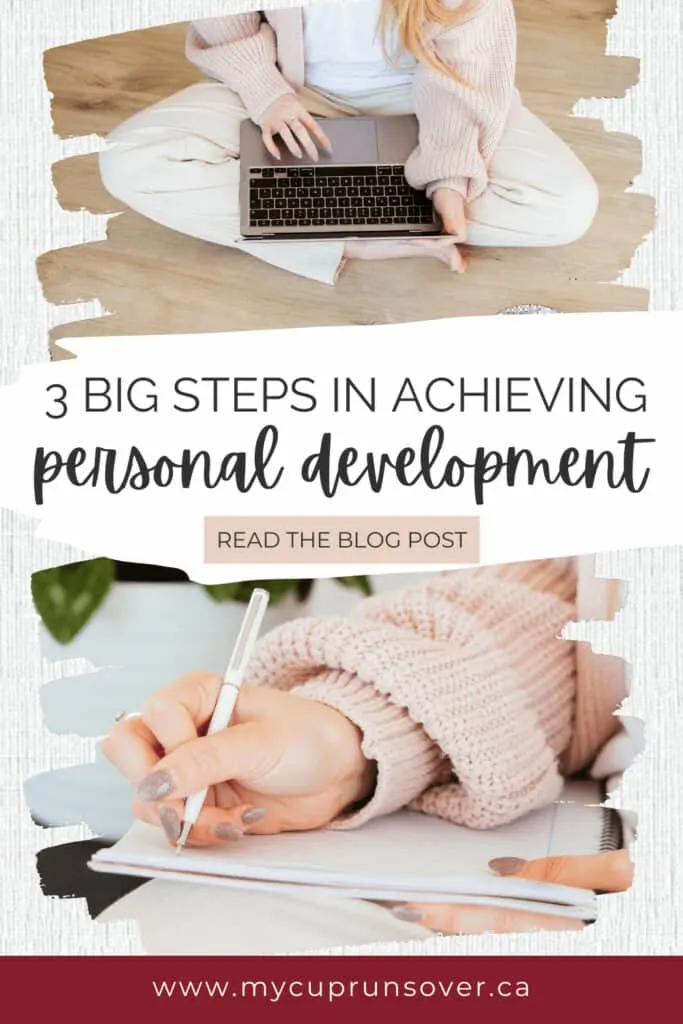One of the most frustrating feelings is the sense that your life is going nowhere. You have big dreams and ambitions, but it doesn’t seem like you’re getting closer to seeing them realized. Making significant life changes is hard, but these three big steps in achieving personal development will give you the perpetual motivation you need to keep going and set you up for success on your self-improvement journey.

Affiliate disclosure: This post may contain affiliate links, which means we may receive a commission if you click a link and purchase something that we have recommended. Please read our disclaimer for more details.
Why Personal Development Plans Fail
Before we get into the three big steps that will help you achieve your full potential, it’s important to understand why people get stuck in the first place. By acknowledging common roadblocks, we can develop an effective personal development plan that allows us to work around those obstacles.
Here are some common pitfalls that could hinder your own progress on your personal growth journey.
- Lack of a personal development plan. Without an adequate plan in place, you can’t expect much positive change to occur. If you don’t know where you are going, it’s impossible to figure out how to get there. If you don’t already have a personal development plan, the first step is to create one.
- Insufficient goal setting. Without goals, your plan lacks a roadmap. What do you need to achieve along the way to your ultimate destination? What new things do you want to learn? What personal experiences do you want to have? When we fail to set goals, we often find ourselves floundering.
- A fixed mindset. A fixed mindset means you believe that your intelligence, abilities, talents, and potential are fixed, meaning they are set from birth and cannot be changed. If you believe this, you will have little motivation to develop new skills or cultivate new knowledge because you don’t see the connection between the specific actions you take and the growth you want to see. With a growth mindset, however, you believe that you can enhance your innate abilities through a lifelong process of learning and pursuing new life experiences.
- Lack of an action plan. The action plan is another key ingredient in your personal development plan. You need to figure out what steps to take to get you closer to your goals. Without an action plan, your efforts may be scattered and uncoordinated, and your success will be left up to chance.
- No accountability. Internal and external accountability motivate you to continuously take the steps outlined in your action plan. For internal accountability, I recommend using a habit tracker to measure your daily progress in specific areas. For external accountability, try to find an accountability partner—someone whose goals are similar to yours and with whom you can check in on a regular basis—or a personal coach.
- Competing interests. Sometimes the problem isn’t that you don’t have goals, it’s that you have too many goals and they are competing with each other for priority in your life. For example, you could be trying to finish a degree, start a business, write a book, and raise a family all at the same time. These are all great goals, but they are each competing for your time, money, and resources. It’s a good idea to look at all your short and long-term goals and prioritize which ones you need to focus on first. Then apply as much of your time and resources toward achieving the highest-priority goals as possible.
- Busyness. Other times, it’s simply the busyness of life that gets in the way. Driving the kids to activities, grocery shopping, laundry, meal prep, doctor’s appointments, pet care, laundry, housekeeping, birthday parties, and, of course, laundry. The endless cycle of tasks necessary for keeping a house and family chugging along is exhausting, leaving little or no energy for personal development goals. Sometimes that’s okay. If you’re in a season where you feel fulfilled with where you’re at personally and professionally, it might not be the right time to pursue personal development goals. But if you’re feeling unsatisfied with life, it’s time to combat the busyness and make some time for yourself.
- Fear. Fear is, for many people, the number one roadblock to growth. Fear of failure. Fear of success. Fear of change. It’s easier to stay in your current situation than step out of your comfort zone into the unknown. To overcome your fears, try to get a better understanding of them. Write them down. Drill down and see if you can find out what the root causes are. Then slowly chip away at them bit by bit. Take baby steps and watch for the results. As your confidence grows, work your way up to bigger steps.
- Procrastination. Procrastination isn’t always a terrible thing. Sometimes, when we have a daunting task looming before us, we procrastinate by completing other tasks—deep cleaning our kitchens, organizing our photos, or tackling that mounting pile of clean laundry, for example. As the deadline draws nearer, our stress response kicks in and we finally take on that important task, knocking it out in less time than we might have thought with more or less the same results. But what happens if there is no deadline? What about the goals that could be done anytime and thus never get done? Life is too short to keep saying, “I’ll get to that next week/month/year.” Impose artificial deadlines on yourself and tackle the most important tasks now.
- Lack of support. Successful people tend to surround themselves with other people who support them and cheer them on as they chase their goals. If you don’t have anyone like that in your life, it is really hard to keep going when things get hard. Whether it’s a few great friends, a personal trainer, an executive coach, close family members, a spouse, or a counselor, you need to find people who want you to succeed as much as you do and who believe in your personal vision. Support groups are another option, and social media and niche websites offer plenty of opportunities to connect with supportive, like-minded people. Find your tribe and lean on it.
- Lack of motivation. Making changes in your life is a lot of work, and it’s only natural that motivation will sometimes lag. When you have bad days, it’s easy to let your eyes lose sight of your life goals and other important things. Try to surround yourself with reminders of your goals, perhaps by putting a vision board on your wall or by tracking progress in a bullet journal. Set mini-milestones along the way and celebrate each little success.
Clearly, there are many factors that can stand between you and the life you want to live. It’s up to you to address these different aspects of your life and come up with a plan that helps you overcome these obstacles so you can take yourself to new heights.
The three steps below are a great way to begin.
1. Get Serious About Goal Setting

The first step in achieving personal development is to set goals. We need to take goal-setting seriously if we’re going to progress on our personal development journeys.
What types of goals should you set?
Ideally, you will set goals for both your personal and professional life.
In terms of personal goals, you might set goals that help you develop positive attitudes, enhance your creativity, or expand your knowledge.
Examples of personal growth goals include:
- Learning a second language
- Keeping a journal
- Reading more books
For professional growth, you’ll want to set goals such as:
- Reevaluating your career path
- Taking professional development courses
- Getting public speaking experience
Make sure you set SMART goals. That is, they should be specific, measurable, attainable, relevant, and time-bound. Doing so will give you a clear idea of what you can reasonably expect to achieve over any period of time.
For more examples of big goals to set on your personal development journey, check out 50 goals to set for yourself and 29 personal improvement goals for growth.
How should you track your goals?
Writing down your personal development goals is only the first step in making the changes you want to see in your life. Now you have to take action on those new goals, monitor your progress, and continually assess how it’s going.
Methods for tracking progress toward goals include planners, habit trackers, bullet journals, and spreadsheets. Our personal development plan template includes a spreadsheet for tracking progress on your short and long-term goals.
Personally, I like to track long-term goals and progress in a spreadsheet and short-term goals and new habits in habit tracker templates pasted into my bullet journal. I find this gives me a chance to see my progress visually on a daily basis, which encourages me to keep moving forward.
2. Develop a Growth Mindset

Carol Dweck defined a growth mindset in the Harvard Business Review as the belief that one’s talents can be developed through hard work, good strategies, and input from others. A fixed mindset, on the other hand, is a belief that our talents are innate and will remain as they are and always have been.
While each person possesses a mix of both these mindsets at any given time, the more you believe that your hard work and effort will contribute to your success, the more likely you are to keep putting in said effort (and thus to achieve your goals).
An effective way to develop a growth mindset is to keep a journal where you record:
- The things you are working on
- The results you’re seeing
- The challenges you face
- Your attitudes toward all of these
Over time, you’ll notice patterns emerging. Paying attention to these patterns will help you shift your mindset. Be patient with yourself if you don’t see results as quickly as you like. Achieving your true potential should take a long time. If you can achieve it overnight, you haven’t set your goals high enough.
Track your progress on a daily, weekly, and/or monthly basis. I like to do all three. Tracking daily progress gives us immediate feedback about how we’re doing. Tracking weekly progress ensures we are hitting some of those larger milestones that need to take place on a weekly basis if we want to see further development in key areas. Monthly progress trackers help us see just how far we can come in a month and maintain the right mindset.
However you decide to track your progress, the most important thing is that you do it. Seeing the direct impact of your efforts is the best way to develop a growth mindset and propel yourself onward.
3. Create and Stick to an Action Plan

When you set your goals, take the time to figure out how you’re going to achieve them. If you’ve started with 1, 5, and 10-year plans, break these down into even smaller segments, such as a quarterly or monthly plan for the first year.
For each of your monthly goals, write down why it’s important, how you’re going to make it happen, and when you will do it by. If you require resources or support to make it happen, write this down too and make a plan for how you’ll secure those.
Your plan may be overly ambitious, and there’s a good chance you won’t complete everything you set out to do within a given month or quarter. That’s why prioritization is essential. List your goals in order of importance so that, if you aren’t able to get to all of them, you will have at least achieved the most important things, and you can carry the rest of the goals over to the next period.
For examples of how to lay out your goals and action plans, check out our bullet journal goal setting spreads.
Plan to reward yourself after you achieve each goal. For example, you might treat yourself to a new book, an afternoon at a coffee shop, or a new piece of equipment related to your personal or professional goals. Incentives give you something tangible to work toward and train your brain to expect a reward for its hard work.
If you’re feeling frustrated with your progress and feel like you’re getting nowhere, don’t give up. Go back to the drawing board and double down on your dreams. Set SMART goals, develop a growth mindset, and stick to your action plan. No matter the specific goals you have for yourself, you will get yourself much closer if you follow these three big steps in achieving personal development.

Sophie Agbonkhese is a writer, homeschooling mother of four, and a recovering overachiever (who occasionally relapses). She is the founder of My Cup Runs Over, a site dedicated to helping busy women simplify and enrich their lives. When she’s not writing or debugging websites, Sophie spends her time reading, dancing, bullet journaling, reading, gardening, listening to audiobooks, and striving fruitlessly to have a clean house for at least five minutes.


selselah asheq
Monday 23rd of October 2023
If you’re feeling frustrated with your progress and feel like you’re getting nowhere, don’t give up. Go back to the drawing board and double down on your dreams. Set SMART goals, develop a growth mindset, and stick to your action plan. No matter the specific goals you have for yourself, you will get yourself much closer if you follow these three big steps in achieving personal development.